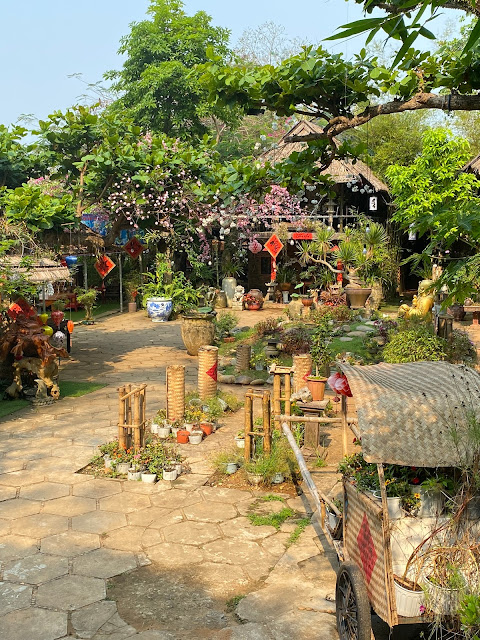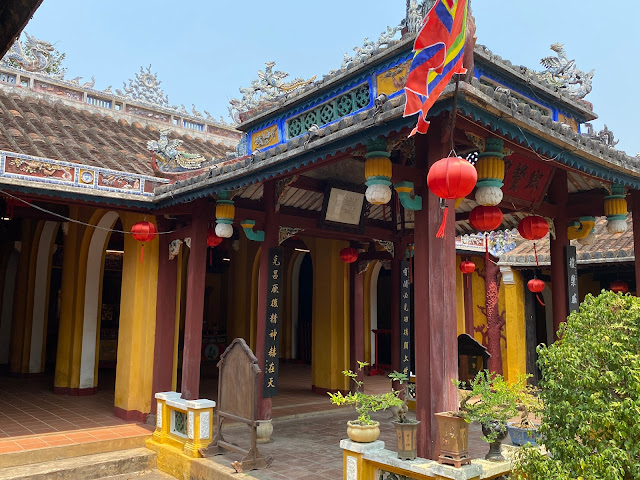We left early the following morning for Thuy Son, one of Da Nang city's five Marble Mountains. These marble and limestone mountains are named after the five elements: Kim (metal), Thuy (water), Moc (wood), Hoa (fire) and Tho (earth). Thuy Son is the largest and most impressive and is explored via a stairway of 156 steps that lead to the summit and the Ong Chong gate where you enter into the labyrinth of caves, temples and pagodas.
 |
| Ong Chong Gate |
 |
| Lumbini Garden outside Ong Chong Gate, simulating the birthplace of Buddha Shakyamuni |
Linh Ung pagoda, a Buddhist shrine built in 1825, is encountered immediately beyond the gate. Da Nang actually has three Linh Ung pagodas but the Thuy Son one is the oldest. Inside there are many offerings and Buddha representations.
 |
| Linh Ung pagoda |
Continuing along the main path, there is a sign to enter the Tang Chon cave. The cave is occupied by 10th century Cham Hindu altars and two buddhas (one sitting and one standing). The Cham or Champa lived in this complex and used it to worship. The Cham once occupied a large area in central Vietnam from the 2nd century to 1832. They were heavily influenced by India, which shows in their art and religion. Just inside the entrance, there are 3 tall honey locust trees planted 160 years ago.
 |
| Temple with three altars and sculpture of the Great Buddha in the middle |
 |
| Altar within temple |
 |
| Guan Yin, the Buddhist goddess of compassion |
 |
| A grotto with sculpture of two wise men playing chess |
Just to the south of the Tan Chon cave is the Xa Loi tower. The tower was built in 1958 by a group of Buddhist monks. It stands at a height of 115 feet and features seven floors, each of which contains a Buddha statue.
 |
| Xa Loi tower |
The path continues onward toward the west side of the mountain, leading to the Van Thong Cave. This cave was more difficult to access. There were uneven, slippery stairs leading to the cave entrance. Inside was a large Buddha statue at the center of the cave and a narrow, slippery corridor leading to an another empty, small area with an opening that allowed sunlight to enter from above.
 |
| Buddha inside Van Thong Cave |
 |
| Access was difficult but we made it |
 |
| Linh Nham cave |
The final cave, Huyen Khong cave, was the most spectacular. The entrance to Huyen Khong cave is a high dome called Hoa Nghiem cave. Huyen Khong cave, the largest of the Marble Mountains, consists of a large chamber enclosed by rock walls vertically cut by flows of rain water. Sunlight falls into it through 5 holes of its ceiling, which are thought to be Buddha fingers, from a height of over 98 feet. It is believed that the cave might have housed temples of Cham people to venerate Hindu gods. This is based on various sculptures discovered in the grotto, some of which date back to the 10th century. There are four temples within the main chamber, each dedicated to a different god or goddess.
 |
| Entering Huyen Khong cave |
 |
| Sunlight filtering through the holes |
 |
| The cave contains several altars and sculptures |
 |
| Staircase |
The last stop at Thuy Son was Tu Tam pagoda. The name "Tu Tam" means "Three Hearings," which refers to the three levels of Buddhist teachings: hearing, thinking, and practicing. It was built by a group of Buddhist monks in the second half of 15th century. It was destroyed during conflict and rebuilt in 1825 by Emperor Minh Mang. It was highly damaged in the American-Vietnam war and renovated in the 1980s.
 |
| Tu Tam pagoda gardens |
 |
| View from the viewpoint |
We checked out the Cam Pho Communal House located on the west end of the historical quarter. Communal houses were both places of worship, administrative centers and meeting halls. Hoi An has 23 communal houses. Dating back to 1818, Cam Pho is one of the oldest villages in Hoi An. The architecture of the communal house is a blend of Vietnamese, Chinese, and Japanese styles.
Next we toured the Nguyen Tuong Family Chapel, built in 1806 by Nguyen Tuong Van, headmaster of the Royal Army of the Nguyen Dynasty in the 19th century. It was a place of worship and memorial for the family as well as a place for cultural and social events. The chapel was damaged by bombings and used as a storage facility during the American-Vietnam war. It was restored twice in 1909 and 2005. The architecture is a blend of Chinese, Vietnamese, and Japanese styles. The interior, including furnishings, décor, and antiquities, have been in place for 200 years. More information on the family is available here.
 |
| Cam Pho Communal House |
 |
| Exterior of Nguyen Tuong Family Chapel |
 |
| Interior of Nguyen Tuong Family Chapel |
The next historical structure we toured was the Phung Hung Ancient House built in 1780. The first owner of the house was a Vietnamese merchant. He named the house “Phung Hung” which means “Prosper.” In the past, the house was a shop that sold spices, silk, chinaware and glassware. It is a typical commercial house representative of Vietnam’s urban areas in the 19th century.
 |
| Interior of Phung Hung Ancient House - the ground floor was formerly the shop |
 |
| Upstairs inside the Phung Hung Ancient House |
 |
| Carp carvings on the balcony |
We toured the Cantonese Assembly Hall built in the late 19th century in Chinese style. The roof is constructed with yin and yang tiles and a dragon carving. The hall was built in 1885 by the Cantonese merchants’ guild and was used as a gathering place for community and religious events of Guangdong Chinese living overseas and working in the Hoi An commercial trading port. A historical photograph of the assembly hall is found at this website.
 |
| Gate to the Cantonese Assembly Hall |
 |
| Exterior of the Cantonese Assembly Hall with dragon roof sculpture |
Next up was Quan Cong Temple, established in 1653 by Chinese immigrants in Hoi An. The temple was devoted to an esteemed Chinese military general, Quan Cong. Quan Cong served in the civil wars during the Three Kingdoms Period in China. He is a symbol of loyalty, bravery, integrity and justice. The legend goes that Chinese merchants would come to Quan Cong Temple to sign contracts for loans because no one would dare to commit fraud in his presence.
 |
| Temple interior |
 |
| Courtyard |
We moved on to the Hoi An Museum of History and Culture. The museum is within the Quan Am pagoda, one of Vietnam’s oldest, built in 1653. We only got a limited tour of this pagoda but I cannot recall why! It must have been closed.
 |
| Photograph of the interior entryway |
The tourism office in Hoi An offers tickets that allow you to tour five historical sites or museums with one ticket. One of the options we chose was a performance at the Hoi An Traditional Art Performance House where we saw a performance using traditional musical instruments and dance. A couple of very brief clips are below:
The road we traveled to Hue was quite busy. There wasn't much time to stop for any roadside attractions, and frankly, it was difficult for me to keep my eyes on anything but the road! Driving is a bit of an art in that no one looks if any traffic is coming before they pull onto the road. Vehicles will come to a stop to park about anywhere, occupying most of the traffic lane. Motorbikes swarm the roads from all directions, and the convention seems to be to honk at people as you are passing. We were able to get a few scenic shots and stopped for noodles before turning onto the Hai Van pass, an approximately 21 km long mountain pass on National Route 1 in Vietnam. It is a scenic coastal route that tourists often experience by motorbike. We had some foggy conditions and, again, there were really very few places to actually catch a view. I didn't feel that the road was "deserted" as some profess, although it was much better than than the highway!






